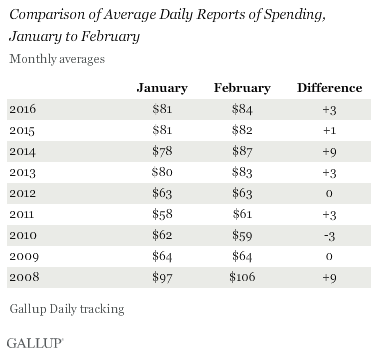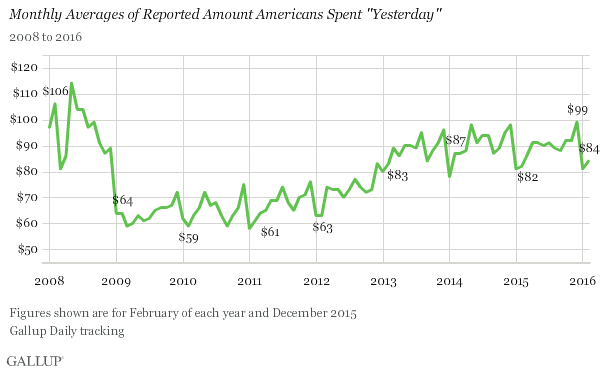U.S. Consumer Spending Up Slightly in February
Thursday, March 10th, 2016
Americans' daily self-reports of spending increased slightly to an average of $84 in February, up from $81 in January. As in most years since Gallup began tracking consumer spending in 2008, spending rose by at least a small amount in February after a post-holiday dip in January.

February's average of $84 is similar to spending levels recorded in the same month from 2013 to 2015. However, it is a significant improvement from February averages below $65 found from 2009 through 2012, as the nation struggled to emerge from the Great Recession and financial crisis. The February 2008 average, $106, is one of the highest monthly averages Gallup has found over the past eight years.
The February 2016 average is based on interviews with more than 14,000 U.S. adults. Each day, Gallup asks Americans how much they spent "yesterday" in restaurants, gas stations, stores or online -- not counting home, vehicle or other major purchases, or normal monthly bills -- to provide an indication of Americans' discretionary spending.
Average spending hovered around $90 for most of 2015, although the January and February averages were significantly lower and the December average was significantly higher than other months. Spending peaked last year at $99 in December, one of the highest averages for any month since 2008.

Bottom Line
The slight increase in spending seen in February is a fairly typical pattern in Gallup's eight-year trend of measuring daily consumer spending. Gas prices began to rise in February and will probably continue to increase through the spring. Still, they are much lower than in recent years, and Americans will probably continue to use the money they typically would spend at the pump on other consumer goods or save that extra money.
With one exception, spending averages have increased from February to March each year since 2010, although they did not in 2008 and 2009. Continued strong spending over the next month -- which the trend suggests is likely, absent a recession -- would help the U.S. economy have a strong first quarter.


